Unknown Artist
The Funny Side of Physic
by Andre Addison Crabtre
[HOME]
[POPULAR RETELLINGS]
Directly or indirectly, these illustrations are based on those from
Richard Verstegan's Restitution of Decayed Intelligence in Antiquities (1605).
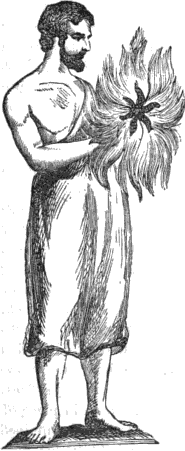 Idol of the Sun Sunday |
||
| The name of our first
day of the week, Sunday, is derived from the Saxon Sunna-daeg,
which they named for the sun. It was also called Sun's-dæg. As
the glorious sunlight brought day and warmth, and caused
vegetation to spring forth in its season, warmed the blood, and
made the heart of man to rejoice, they made that dazzling orb
the primary object of their worship. When its absence brought
night and darkness, and the storm-clouds shrouded its face in
gloom, or the occasional eclipse suddenly cut off its shining,
which they superstitiously attributed to the wrath of their
chief deity, it then became the object of their supplication.
With them, and all superstitious people, all passions, themes,
and worships must be embodied — must assume form and dimensions,
and as they could not gaze upon the dazzling sun, they
personified it in the figure of a man — as being superior to
woman with them — arrayed in a primitive garment, holding in his
hand a flaming wheel. One day was specially devoted to sun
worship. |
||
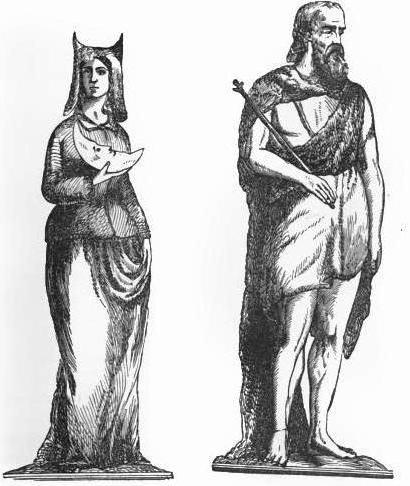 Idol of the Moon Tuisco Monday Tuesday |
||
|
The second day of the week the Saxons called Monandæg, or Moon's
day; hence our Monday. This day was set apart by that idolatrous
people for the worship of their second god in power. In their
business pursuits, as well as devotional exercises, they devoted
themselves to the moon worship. The name Monandaig was written
at the top of all communications, and remembrance had to their
god in all transactions of the day. Each monath (new moon or
month) religious (?) exercises were celebrated. The idol
Monandæg had the semblance' of a female, crowned or capped with
a hood-like covering, surmounted by two horns, while a basque
and long robe covered the remainder of her person. In her right
hand she held the image of the moon. The third object of their worship was Tuisco — corresponding with German Tuisto—the son of Terra (earth), the deified founder of the Teutonic race. He seems to have beeu the deity who presided over combats and litigations; "hence Tuesday is now, as then, court-day, or the clay for commencing litigations." In some dialects it was called Dings-dag, or Things-day — to plead, attempt, cheapen: hence it is often selected as market-day, as well as a time for opening assizes. Hence the god Tuiseo was worshipped in the semblance of a venerable sage, with uncovered head, clothed in skins of fierce animals, touching the earth, while he held in his right hand a sceptre, the appropriate ensign of his authority. Thus originated the name of our third day of the week, and some of its customs. |
||
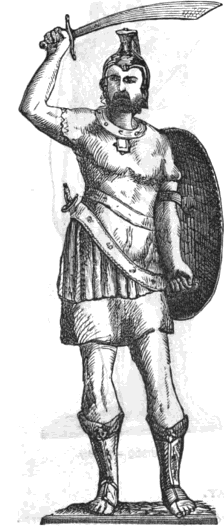 Woden Wednesday |
||
|
Wednesday was named for Woden, — the same as Odin, — and was sacred to the divinity of the Northern and Eastern nations. He was the Anglo-Saxons' god of war, "who came to them from the East in a very mysterious manner, and enacted more wonderful and brilliant exploits of prowess and valor than the Greek mythologists ascribed to their powerful god Hercules." As Odin, this deity was said to have been a monarch (in the flesh) of ancient Germany, Denmark, Scandinavia, etc., and a mighty conqueror. All those tribes, in going into battle, invoked his aid and blessing upon their arms. He was idolized as a fierce and powerful man, with helmet, shield, a drawn sword, a gyrdan about his loins, and feet and legs protected by sandals and knee-high fastenings of iron, ornamented with a death's head. |
||
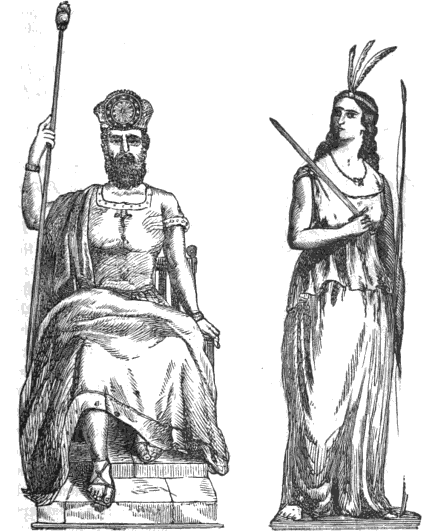 Thor Friga Thursday Friday |
||
|
From the deity Thor our Thursday is derived. This Saxon god was the son of Woden, or Odin, and his wife Friga. He was the god of thunder, the bravest and most powerful, after his father, of the Danish and Saxon deities. Thor is represented as sitting in
majestic grandeur upon a golden throne, his head surmounted by a
golden crown, richly ornamented by a circle in front, in which
were set There is nothing in the name or attributes to indicate the ill luck which superstition has attached to the day. |
||
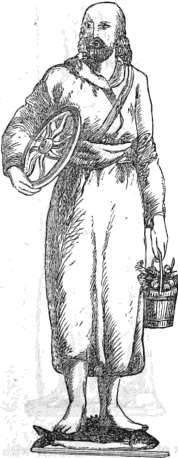 Seater Saturday |
||
|
The god Seater, for whom the last day
of the week is named, is the same as Saturn, which is from Greek
— Time. |
||
[POPULAR RETELLINGS]